Save Vestas Blades
Whitehall, London. Wednesday, 22 July 2009
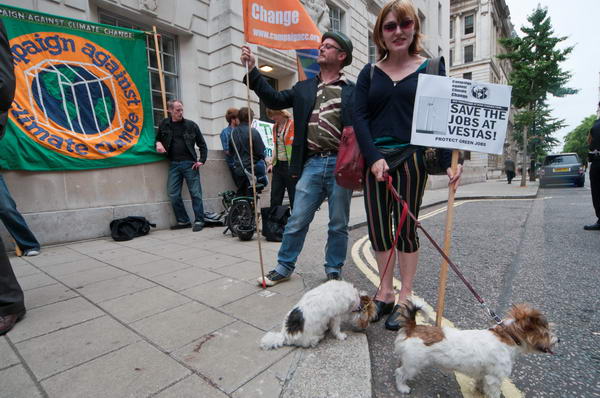
Save the jobs at Vestas!
more pictures
A hundred or so people turned up at a demonstration organised by the Campaign
Against Climate Change (CCC) outside the offices of the Department for
Energy and Climate Change in Whitehall Place following the decision by some
workers at Vestas Blades UK to occupy the Isle of Wight factory.
They called on the Government to take action to preserve green jobs at Britain's
only manufacturer of wind turbine blades. Speakers included Phil Thornhill,
CCC National Coordinator, Darren Johnson, Green Party and LIberal
Democrat MP Simon Hughes.
Speakers condemned the actions of the police on the Isle of Wight who have
been aggresively policing the occupation and preventing suporters taking food
to the workers in the factory.
The attitude of the government to the workers at Vestas was contrasted to
the incredible amounts of public money given to support the banks. Simon Hughes
was the subject of some vigorous heckling when he stated that nationalisation
was not the answer, although he made it clear he would be happy to see the
workforce being supported to take over the operation.
The factory has been successful and obviously there is a great future for
the industry, but the Danish company is moving production to the USA where
it can get greater government support.
more pictures
Protest Against Calais Camp Clearances
French Embassy, Albert Gate, London. Monday 20 July, 2009
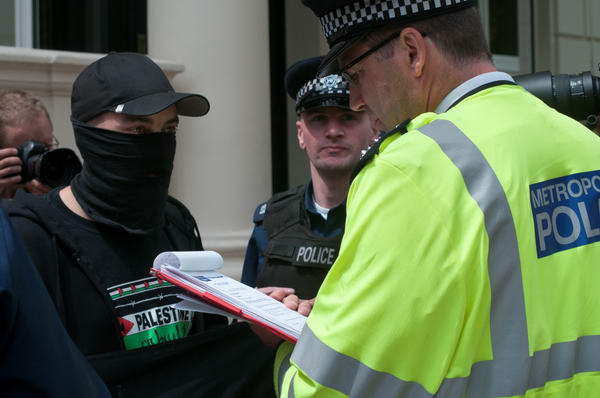
Policeman warns demonstrator
more pictures
London and Brighton NoBorders groups demonstrated outside the French
Embassy at lunchtime against the planned destruction of the 'jungles' housing
around 1,800 migrants around Calais, expected to start the following day.
Around 25 people turned up, fewer than expected as some were already on their
way to protest in Calais.
The police have refused to allow humanitarian associations in Calais to provide
shower facilities for the migrants in the jungles, and French immigration
minister Besson has talked about the camps only being destroyed with "dignity";
protesters reply "there is no dignity in a crime against humanity."
In Calais, the banners and chalked notices read
"Arrestations
Detention
Expulsions
INDIGNATION!"
but those at the London protest were simpler; " No Deportation merci"
read one held up in front of the embassy under the French and European flags.
French police are expected to hold the detained migrants in secure hostels
before forcibly putting them on flights; they are expected to start with the
large group of Afghans who they intend simply to dump in Kabul, where many
may have no support and face dangers - some at least had very good reason
to flee the country.
Police attempted to get the demonstrators to occupy a pen on the other side
of busy Knightsbridge, almost out of sight and largely out of hearing of the
embassy. Instead they stayed mainly in the side road containing the embassy
entrance. A small group of masked demonstrators holding a black banner "NO
BOMBS NO BORDERS" was moved several times under threat of arrest on various
grounds, including the that of obstruction, even when they were clearly not
causing an obstruction.
It was a noisy demonstration, thanks to the sound system from Bicycology
which allowed a number of people to tell the French what they thought, as
well as providing some rather loud music which wasn't to everyone's taste.
Police let one of the demonstrators attempt to deliver leaflets to the embassy,
and although they would not take these, a diplomat did come out and talk with
her for some time. And of course I photographed this, although one police
officer, CW 3176, insisted on playing a silly game and standing in front of
me wherever I moved to do so. As the MPS guidelines state "We
(the police) should actively help them (the media) to carry out
their responsibilities provided they do not interfere with ours."
A colleague at one point noticed a police photographer who was skulking behind
a police van pointing a very long telephoto lens directly at the two of us.
We went and challenged him, and he denied that he had photographed us and
said that he had absolutely no interest in doing so.
There were indeed a number of curious games being played by the police, with
one officer moving the people holding a banner on the central pavement of
Albert Gate on the grounds that it was causing an obstruction, and letting
them hold it - to their surprise and that of some other officers - on the
roadway directly in front of the embassy entrance. I gained an impression
that while some were trying to facilitate dissent within the legal limits
there were others who preferred the more traditional Met approach.
The protest was scheduled to finish after 90 minutes at 2.00pm, and until
very late on it seemed it would end without incident. However at 1.43pm, a
team of police troublemakers in blue overalls marched in, the TSG, several
of them armed with tasers.
Police then tried to persuade the protesters to move into the pen across
the road for the remaining 15 minutes of their demonstration. One masked protester
was briskly led away by three officers for 'obstructing a police officer',
who was photographing the event.
The rest of the protesters were then threatened with arrest under Section
14 of the Public Order Act unless they moved to the pen. Since it was by then
1.55pm, they crossed the road and then decided it was time to go to the pub
rather than into the pen.
more pictures
Sex Workers Masked Parade
Soho, London.Sunday 19 July, 2009
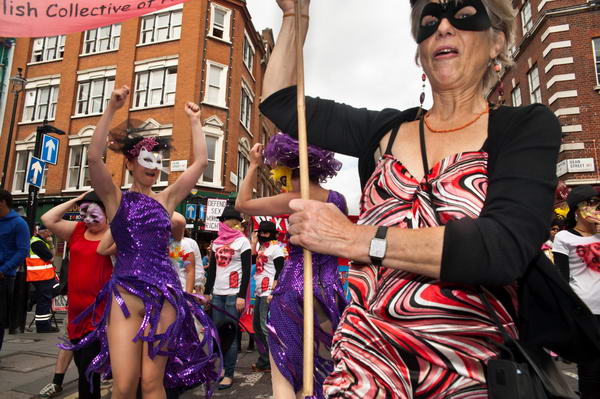
The parade crosses Dean St
more pictures
Sex workers and supporters held a masked parade around Soho as a part of
the annual Soho Festival, thanking the community for their support
in helping to keep women safe.
The noisy and colourful parade led through Chinatown and up to Soho Square
stopping at intervals to address people in the streets and pavement cafes.
Attempts by the police to close down premises used by some sex workers were
defeated in February with the help of local people; these were small women-run
flats, which are many times safer than working on the streets, and also casue
fewer problems for others living in the area. The real motive behind the attempted
evictions appears to be to gentrify the area.
The masked parade was organised by 'Soho Working Girls' and the
'English Collective of Prostitutes', who exposed the false claims
behind proposed legislation that allege that a very high proportion of those
involved in prostitution are 'trafficked' women. They state: "Research
published on 10 July proves that most sex workers are not trafficked. We are
mothers, daughters, sisters, grannies, aunties struggling to support ourselves
and our families, just like other women." The research referred
to is the ESRC Project: Migrants
in the UK Sex Industry.
The sex workers want to stop the Policing & Crime Bill (PCB)
currently going through parliament. Based on the assumption that all prostitution
is rape this would criminalize anyone who paid a prostitute. It also makes
it easier for police to arrest women on the street, close down flats they
are using for their work and seize assets and earnings. It also contains proposals
for the compulsory "rehabilitation" of sex workers.
What these sex workers want is a safe working environment and legislation
and action by the police that concentrates on cutting down actual rape and
other violence against women - including trafficking involving coercion.
The current attempts by police and Westminster Council to close down premises
increase the dangers to sex workers, and raids by immigration authorities
and social services have the effect of driving prostitution underground and
increasing danger to both the women and their children.
The parade stopped in Green Court outside some of the flats that the council
wanted to close for a short speech before going on to take the stage at the
festival in St Anne’s Gardens. After a welcome from the Soho Society
there were several short speeches of support, including by the Rector of St
Annes, Soho, Fr David Gilmore.
more pictures
Brixton Promenade & Urban Art
Brixton, London. Saturday 18 July, 2009
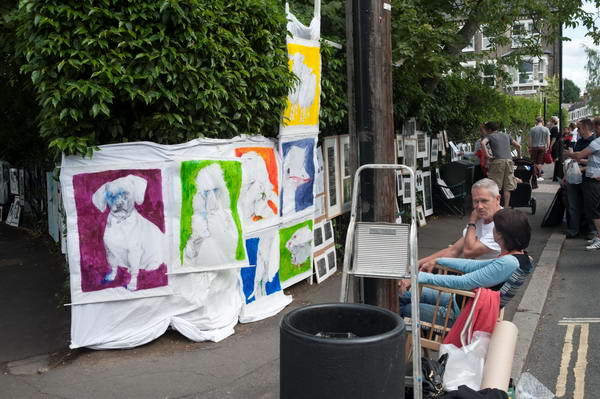
Urban Art show in Josephine Avenue
more pictures
I'd come to Brockwell Park for the annual Lambeth Country Show with Dave;
its an event we've both photographed in the past, although its more than ten
years since I really did much there. And walking briefly through it, neither
could summon up much enthusiasm, except for a cup of tea at the cafe in Brockwell
House on the top of the Hill.
It's a nice house, built in 1811-13 for the wealthy city glass maker John
Blades, who was then Sheriff of London and Middlesex in 1812–13 and
had a good view of most of it from there, although I think the trees have
been allowed to grow rather too much since. A public campaign to establish
a park in Brixton at first concentrated on the site of Raleigh House on Brixton
Hill, but the money raised was then diverted towards the much larger estate
of Brockwell Park, which was bought as a Metropolitan Open Space in 1892,
largely thanks to the work of Norwood MP Thomas Bristowe, who unfortunately
collapsed and died from a heart attack during the opening ceremony.
We walked down from the house towards some of the gardens. Unfortunately
the community garden was closed, but we were able to visit the Old English
Walled Garden, converted from the houses kitchen garden by J.J. Sexby, the
Chief Officer of Parks of the LCC, who also added lakes, waterfalls and a
swimming pool - as well as establishig the first tea rooms in the hall.
It's hard to imagine, sitting in or walking around the garden that you are
in Brixton, hard to think of anything further from the public image of Brixton,
and good to see that people were enjoying its peace.
Dave's lived in the area all his life, and grew up on the Tulse Hill estate
we came to next, a typical LCC estate started in 1939, built with an access
from the park, solid well-spaced blocks completed after the war. Dave went
to the same local boys school, Tulse Hill School, as Ken Livingstone, redeveloped
as affordable housing where Jean Charles de Menezes was living in 2005 (the
girls school, which overlooked Brockwell Park, was replaced by a luxury gated
private development.)
Through the estate we walked along and up to Josephine Avenue, where the
annual outdoor Urban Art fair was taking place, London's largest such event.
The late nineteenth century development of this road, formerly a part of Rush
Common was governed by Lambeth Manor Inclosure Act of 1806 which prohibited
building within 150 ft of the road. Houses on both sides are set back by this
distance, with a wide path designed for carriages immediately in front of
them and then an area now largely divided into individual gardens between
that and the road, with an iron fence. The street side of this is covered
with paintings, prints and drawings - and a few photographs - as pitches for
the artists taking part in the fair.
These often neglected gardens made the street notorious in the recent past,
with kerb crawlers and prostitutes taking advantage of its relative isolation
from the houses - and some carrying out their trade alfresco in its bushes.
An active residents group has done much to clean up the area - including the
organising of the Urban Art fair and more recently, a small community garden
adjoining the 'Poet's Tree'.
Local legend that Queen Elizabeth I came up the Rvier Effra by boat to meet
with Sir Walter Raleigh here under this ancient oak is almost certainly without
any foundation, as the Effra was almost certainly not navigable to this point
(Henry Hastings, the first Baron Loughborough, who leased the manor of Lambeth
Wick got an Act of Parliament to make the Effra navigable from Brixton Causeway
to the Thames years later in 1664, but died before he could do so) and although
there was a Raleigh House nearby on Brixton Hill (where Raleigh Gardens is
now) there appears to be no known connection between the man and Brixton.
But he certainly was a poet - as well as a courtier, explorer and pirate.
more pictures
March of Repentance
Hyde Park, London. Saturday 18 July, 2009
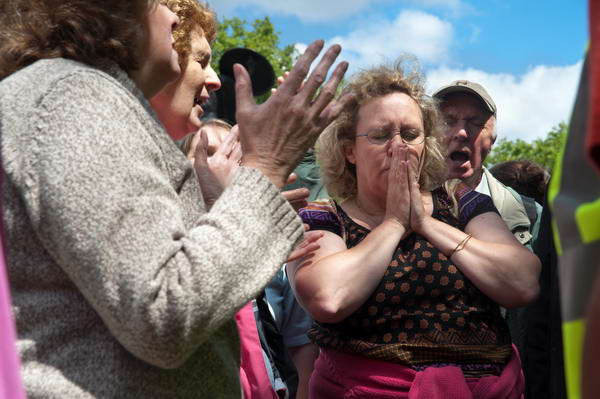
Prayers for the nation
more pictures
Described on the web site as a "humble call out to our nation for
change, with one message Repentance", the march was organised by
"a concerned and growing group of believers across the denominational
divides crying out for Godly change in the Church and in our Nation."
The march was a call to the church and to the nation to turn away from false
gods and to turn around "towards what is good which is God, in order
to put the 'Great' back into Great Britain." You can read more about
the event on their web site
Before the march to a rally in Traflagar Square, those taking part gathered
in Hyde Park, forming small groups standing on the grass below the statue
of Achilles, praying for repentance. Some prayed fervently and loudly, others
more privately, and a few were speaking in tongues, with one or two falling
to the ground as the spirit moved them.
Although the stewards welcomed us to the event, it was a little difficult
to photograph, not wishing to be too obtrusive. After around half an hour
of prayer the group, by this time perhaps around 500 people, came together
and were led in singing before walking out of the park and under Park Lane
to the assembly point. More people joined them here, and by the time the Shofar
(ram's horn) was blown into the megaphone to signal the start of the march,
there were around a thousand setting off to Trafalgar Square. I left at this
point to go elsewhere
more pictures
Bonuses are Back Pig Party
Royal Exchange, Bank, London, Friday 17 July, 2009
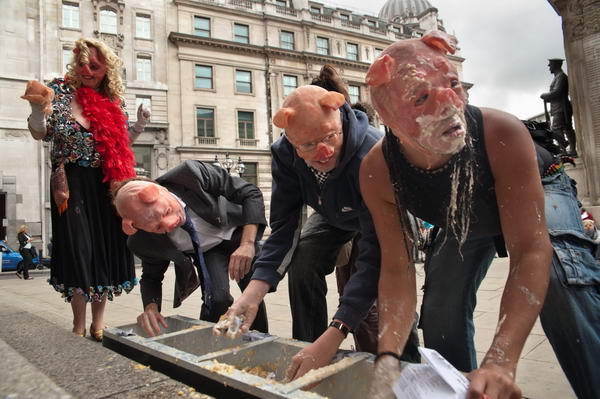
Pigs wallow in the bonus trough, watched by Miss Piggy
more pictures
Despite everything that has happened over the past year, bankers are still
getting bonuses, often at quite obscene levels, far in excess of most people's
annual incomes.
City pigs are truly back with their snouts in the trough, and to celebrate
this, Chris Knight and others from the 'The Government of the
Dead' came into the heart of the City of London tonight for a 'Bonuses
are Back Pig Party', wearing pig masks and setting up a trough with 'Pig
Pounds' mixed with pig swill and getting snouts down and bottoms up to wallow
in it.
Camilla, Tim, Simon and others had reworded some well-known pig songs for
the occasion, including a number of hits by Miss Piggy, Pinky and Perky, The
Simpsons and Piggy Pie, and in between sessions at the trough the pigs danced,
sang and mimed to the tracks.
Familiar to all with is 'Lets Twist Again', once recorded by Pinky
and Perky but which now became:
"Come on let's scam again
Like we did last summer
Come on let's scam again
Like we did last year
Come on let's scam again
Scamming time is here."
Chris Knight treated (if that's the correct word) us to his singing of the
traditional labour movement song, 'The Man Who Waters the Workers Beer'
but fortunately mainly kept to shouting out the news that 'Bonuses are
Back' and inviting the homeward workers to come and swill in the trough,
all provided at the taxpayers expense thanks to Gordon Brown.
City workers on their way home stopped in amazement and some tourists donned
the latex masks provided and joined in while others simply photographed one
of the slightly more unusual sights of London. The City of London Police (given
the occasion it would be confusing and unfair to call them pigs) stood back
and watched. Like most demonstrations it was unlikely to create any threat
to public order without their intervention, and when I left around an hour
and a half after the event started, there had been absolutely no problems.
more pictures
Climate Emergency Alternative Parliament
Old Palace Yard, Westminster, London. Wed 15 July, 2009
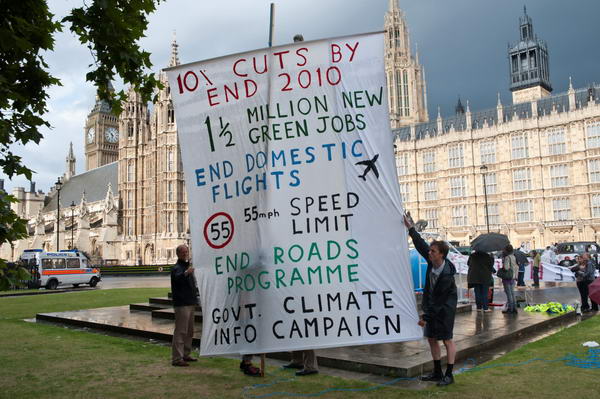
The protest took place opposite the Houses of Parliament
more pictures
In response to the muddled and inadequate response of the UK Government over
the challenges of climate change, an emergency session of an alternative Parliament
was held by the Campaign against Climate Change (CCC) on Wednesday
evening, 15 July, in Old Palace Yard opposite the Houses of Parliament. Around
150 people turned up to stand in the intermittent rain, some taking advantage
of the shelter of the plane trees to the side.
Four bills were debated at this parliament, calling for immediate 10% cuts
in carbon emission by the end of 2010, the creation of 1.5 million new green
jobs, an end to airport expansion and a ban on domestic flights, an end to
the road programme and the introduction of an overall 55 mph speed limits
as well as an informed government campaign about the effects of climate change.
The sitting of the emergency parliament was opened and closed by the 'Green
Queen' and presided over by a speaker who lost his wig when Colin
Challen MP, one of the speakers, pointed out that there had been a recent
change to this effect in proceedings in the House over the road.
Other speakers included Darren Johnson, leader of the Green Group
in the London Assembly, John Stewart of HACAN, Tim Helweg-Larsen,
Director of the Public Interest Research Centre, Chris Baugh, Assistant
General Secretary of the Public and Commercial Services Union (PCS) and
Deepak Rughani from Biofuelwatch.
Drew, a former worker from Vestas Blades UK Ltd on the
Isle of Wight talked about the impending closure of the UK's only wind turbine
manufacturing plant there with the loss of 700 jobs. The company is making
profits here but is moving production to the USA to take advantage of the
greater support from the US government under Obama.
The final session was a spirited call by Climate Rush’s Tamsin
Omond, wearing her suffragette 'Deeds Not Words' sash, for everyone
to join in and occupy Parliament at the end of the National Climate March
on Dec 5 which was followed by CCC National Co-ordinator Phil Thornhill, who
stressed the importance of the clearly argued political approach and mass
demonstrations which the CCC has been organising for more than ten years.
On the CCC site it says:
The Climate Emergency should be the overriding priority of every politician
and to which all available human and material resources should be immediately
directed. Those in power, however, are not currently acting with anything
approaching the degree of urgency and resolution required by the circumstances
– until they do it is the duty of each and every one of us to do our
utmost to influence them to do so. If they will not declare a Climate Emergency
and act accordingly then we have to do everything possible to communicate
that sense of emergency to others and to push for the action that it demands.
more pictures
Procession in Honour of Our Lady of Mount Carmel
St Peter's Italian Church, Clerkenwell, London. Sun 12 July, 2009
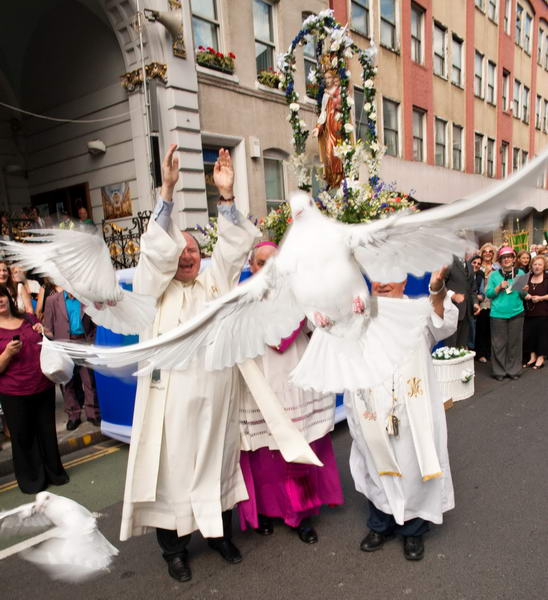
One of the doves flew straight at me - this is the full width of an ultra-wide
angle image
more pictures
The annual Procession in Honour of Our Lady of Mount Carmel, first
made its way around Clerkenwell from St Peter's Italian Church in 1883, twenty
years after the church was consecrated. It was the first Roman Catholic event
allowed on English streets for around 350 years after Henry VIII broke from
Rome and created the Church of England in 1534, and the local police were
given special permission by Queen Victoria for it to take place.
Then the church was surrounded by the small crowded streets of Saffron Hill
or 'Little Italy' in which much of the country's Italian population lived.
Few now live in the neighbourhood, but many return from all over London and
towns and cities across England for the annual procession. It became increasingly
colourful in postwar years with many on foot wearing biblical costumes and
colourful floats carrying tableaux of biblical scenes, as well as various
associations carrying banners, images and statues of the saints around the
area. There is also a group of first communicants as well as the priests and
other clergy.
A lively Italian festival - the Sagra - with food, drink, dancing and more
- fills a street below the church, and thousands turn up to watch the procession
and enjoy the atmosphere. I've been going there for a dozen years or more
and try to get there each year. You can see pictures from 2008,
2007, 2006,
2005, 2004,
and 2003 on this
site.
At the start of the procession, three white doves were released by the clergy,
including on this occasion Bishop Alan Hopes. One of them flew directly at
me and I felt the beat of its wings through my hair just after I had taken
its picture.
The clergy join the procession in front of the last float, which carries
the statue of Our Lady of Mount Carmel, and a large crowd of parishioners
follows after it.
more pictures
London Bridge - 800
London Bridge, City of London. Sat July 11, 2009
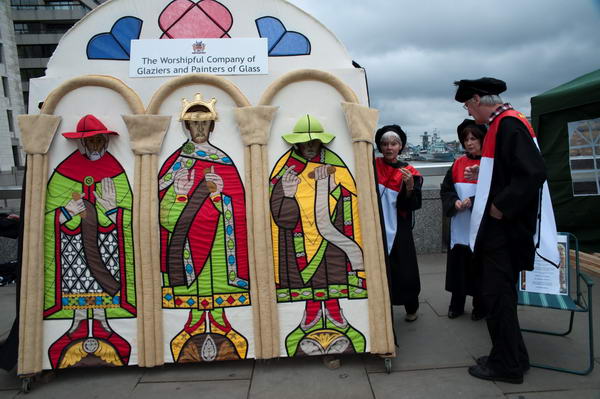
a few more pictures
Somewhere recently I've written before about the history of London Bridge,
from the first bridge (or bridges) established in Roman times, though various
Saxon and Norman attempts that we know very little about, and were generally
only recorded when they were destroyed, either deliberately in the fight against
the Danes, or by storm or fire.
I'm not clear why all these early bridges were wooden. The Romans certainly
built stone bridges, some still standing, with pretty impressive arches, both
semicircular and segmental. Their acheivments were only really surpassed relatively
modern times. But for some reason - perhaps the lack of suitable local stone
or related to the shifting and tidal nature of the river - London only qualified
for a wooden structure.
It was Peter de Colechurch who decided a wooden bridge would be a better
bet well over a thousand years after the first bridge, and started building
one in 1176. It was a lengthy job, and was only finished 33 years later, and
it was also very expensive. To get back the cost houses were built on the
bridge (as well as a chapel in the middle) and it soon became a thriving medeival
shopping centre. There was actually very little space left for traffic to
get across it, traffic moving in both directions on a 12 foot wide roadway
(and in 1722 we got our first Higway Code, with the Lord Mayour laying down
that carts coming from Southwar should stick to the west side, and those going
south from the City drive on the east.) You can get a good idea of its width
from going to the church of St Magnus the Martyr, as its entrance porch is
the only remaining part of the bridge, and if the church is open you can go
inside and view (sometimes through a rather thick haze of incense) a large
model of the whole bridge.
Peter's bridge - with pretty well constant repairs and several major disasters
- lasted until 1831 when a new bridge designed by John Rennie opened for business,
around 100 ft upstream. Alcoves from the old bridge are in Victoria Park and
Guy's Hospital. That bridge was sold to a US millionaire in 1968 and the outer
cladding of it shipped to Arizona as a feature for an English theme park,
though most of the stone was dumped in a Devon quarry, and one span remains
at the south end over Tooley St. The current bridge opened in 1971.
I arrived just a few minutes before the event to celebrate 800 years finished,
thanks to the closure of both the District and Jubilee line for planned engineering
works almost cutting off Newham from central London.
a few more pictures
Newham Childrens' Carnival Procession
East Ham, London, Sat July 11, 2009
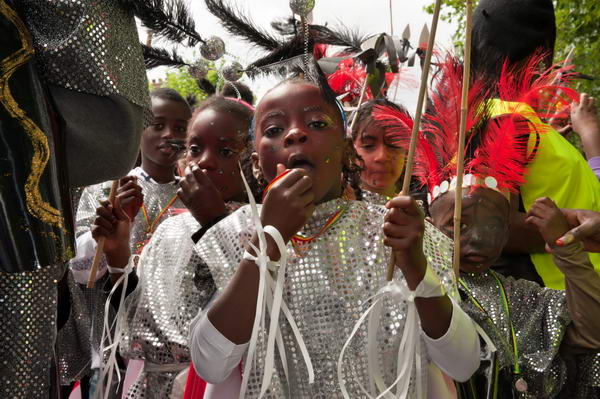
more pictures
Newham Carnival seemed rather smaller than when I photographed it in 2007,
but it was still a lively procession, with lots of kids having fun. The Mayor,
Sir Robin Wales, came and joined in, though I found his performance rather
embarassing. He is one of only 13 elected mayors in the country and has held
that post since 2002, although he has been leader of the council since 1995.
Newham had the first Labour council in the country, and the first Labour
MP - Keir Hardie. I'm not convinced it's a good advertisment for the party
- and Stratford centre is certainly one of the worst developments of its kind,
although Stratford City and the Olympic site look set to be even more disastrous.
Newham has long had some of the poorest areas of London. I wrote more about
part of the borough - Canning Town - when I led a walk around the area in
2007. As well as an account
with directions there are more pictures on My
London Diary. The borough also features in many contributions here about
the Olympic site and other pages, and in my site on the
Lea Valley.
My route back took me (slowly by bus) to Canning Town station which following
the demolition of Pura Foords now has an unobstructed view across Bow Creek
to Canary Wharf. Unfortunately the riverside walk built around ten years ago,
in part to give easier access to the station from housing and offices across
the river in South Bromley, remains firmly closed.
more pictures
Big Brew
Finchley and Edgware, London. Sat July 11, 2009
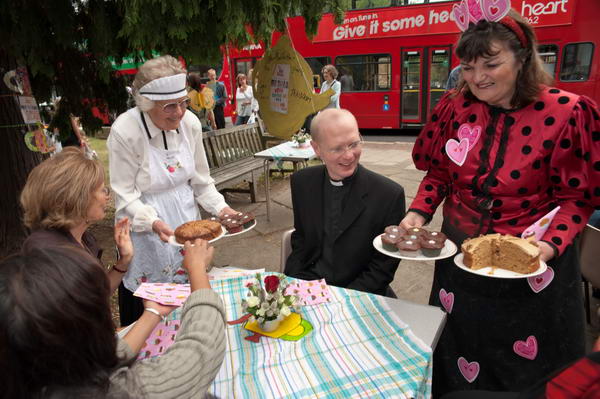
Anglican churches across Greater London organised events on July 11, giving
away fairly traded tea and coffee. The Diocese of London organised the day
to promote Fairtrade and to emphasise the role of churches in encouraging
others to buy fairly traded products, but individual chruches though up their
own ideas to innvolve the local community.
I photographed the Bishop of Edmonton, The Right Revd Peter Wheatley, visiting
two of the seventy or so events. At St Mary's Finchley, tables were spread
on the pavement serving tea coffee and a large assortment of delicious looking
cakes, and Barnet Mayor Councillor Brian Coleman as well as the leader of
the opposition came along too. Children from the church's lively drama group
held a 'Mad Hatter's Tea Party' and there were waitresses in caps and aprons
and everyone seemed to be having a good time.
At St Margaret's Edgware, as well as tea and coffee in the church visitors,
who included local MP Gareth Thomas could also try their hand at ringing the
church bells. Unfortunately neither the bishop or I could stay long as we
both had other events to attend.
more pictures
International Brigade Commemoration
Jubilee Gardens, London. Sat 4 July 2009
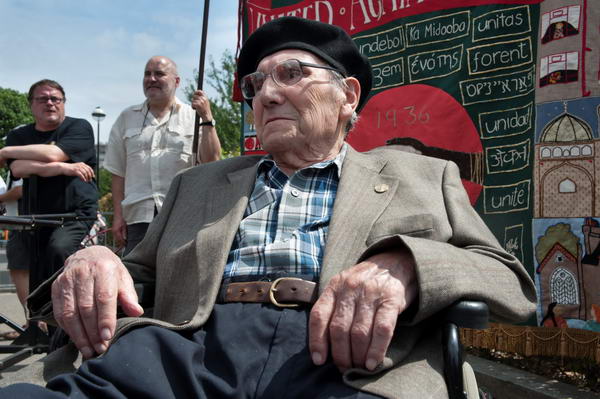
There are still a few alive who went to Spain - Lou Kenton, now 101, was an
ambulance driver.
I was pleased to be able to get to this year's event, having missed it last
year, although I was held up and arrived late. Every year there are fewer and
fewer of those who went to Spain to fight or work in the medical services, all
now in their 90s or older. And every year a list of those who have died in the
past year.
One of those who died in the last year was of course Jack Jones, and I was
moved as was everyone else by the tribute to him given by Sam Lesser, still
going strong at 94. Others who died in the past year and were also remembered
were Bob Doyle, Bernard McKenna and Rosaleen Ross (Rosaleen Smythe when she
went to Spain.)
Earlier this year, those still surviving were given Spanish passports, and
the Spanish Ambassador again took part in today's ceremony, conveying his
nation's gratitude to these brave volunteers, who, as C Day Lewis wrote in
his 1938 poem 'The Volunteer' quoted on the memorial went because
their "open eyes could see no other way."
more pictures
Pride London
Baker St to Trafalgar Square, London. Sat 4 July 2009
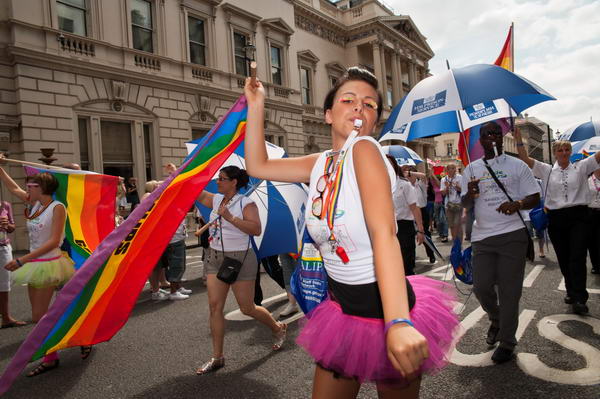 HM
Prison Service: "Banged to Rights"
HM
Prison Service: "Banged to Rights"
more pictures
I first photographed the LGBT Pride march in London in the early
1990s, when it was very much a personal and a political event. Then it took
some courage for some of those present to come out on the street, and they
were sometimes wary of being photographed. Things have changed pretty dramatically
over those 15 or more years, and Pride is largely a very different event,
much more of a corporate than a personal or political one. Of course the LGBT
community being what it is there is still plenty of room for the unusual,
the eccentric,the flamboyant, the spectacle. And even, though perhaps rather
more at the edges, the political.
Some of the organisations are of course political - most obviously those
such as the trade unions and organisations such as Stonewall and other campaigning
groups including Amnesty, but at Pride their contributions are generic rather
than specfic.
Outrage! was of course different, with placards demanding gay marriage
- and making particular reference to the Brown family - the PM's wife was
in the parade, although I didn't bother to go to the press call where she
met Peter Tatchell, as I wanted to attend another event then. There was also
a smallish anarchist presence near the back of the parade, as well as a few
individuals scattered through it.
As usual there were a number of Christian groups taking part in the event
(as well as some from other religions) and on the corner as the march turned
into Pall Mall, a small group of Christian fundamentalists in Waterloo Place
preaching hell-fire against the event in what the United Protestant Council
describe as their "annual witness against New Sodom, parading its
shame on the streets of London." Police kept the public and photographers
at a safe distance from them.
The same group, led by Pastor David Carson of the Zion Tabernacle in Chester,
were also in Trafalgar Square on June 13, holding one of their irregular Gospel
witnesses - the first for two years - when hundreds of naked men and women
rode by on bicycles in "yet another demonstration of the depths of
depravity which is so rampant in our nation." There are unfortunately
no pictures of this on their blog, but you can see plenty on My
London Diary. As well as of course more pictures from London Pride.
more pictures
Climate Rush Palm Oil Gala
Millennium Hotel, Mayfair, London. Wednesday 1 July, 2009
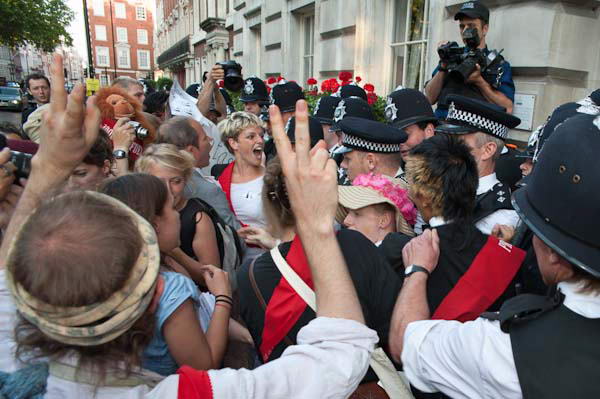 Rushers
outside the doorway of the Millennium Hotel - with a well-known police photographer
Rushers
outside the doorway of the Millennium Hotel - with a well-known police photographer
more pictures
The Climate Rush held a Gala Dinner and Dance outside the Millennium Hotel in
Grosvenor Square, Mayfair, London as a protest against the deforestation of
tropical forests to grow biofuel crops. A jazz band played, and suffragettes
and orangutans danced in the street outside as profiteers from global despoliation
were having their own party inside.
Tropical forests are being felled, releasing vast amounts of carbon dioxide,
to grow biofuel crops such as palm oil. Palm oil production is causing particular
problems in Indonesia, where indigenous people have seen their traditional
lands taken over by companies for palm oil production under unfair laws. The
forests were their land and their living, and those moved out are finding
it hard to survive, often being left without proper clean water supplies in
marginal areas. Many have been violently attacked by armed security forces
and police. The promises made by the palm oil companies to the people have
not been kept, and the regulations which offer them some very limited protection
have not been enforced.
Replacing natural forests by palm oil plantations causes pollution and problems
of flooding, as natural drainage is disrupted. Most of the wildlife is eliminated
as its habitats are destroyed, and species including the orangutan and the
Sumatran tiger are under threat. A detailed report for 'Friends of the Earth',
'Losing Ground', looked in particular at the human rights issues
and concluded that "The EU target to increase agrofuel use is misguided,
risking environmental damage and human rights abuses on an even bigger scale."
The Climate Rush flyer for the event states, "90% of orangutans
have disappeared since the Suffragettes first appeared 100 years ago."
The event started with a picnic in the park, the garden of Grosvenor Square
opposite the hotel. Then the jazz band began to play and people moved out
onto half of the street, rejecting the pen police had created "for
your safety." Unlike many other occasions, the police made no attempt
to force demonstrators into the pen, and while keeping a close eye on the
event (and filming and photographing) they concentrated on protecting the
hotel with a small line of officers.
After dancing on the street for around half an hour there was a "rush"
across the street to the hotel doorway, which made little impression on the
row of police across its front. Many of the police seemed rather amused throughout
the event, although there were one or two who slightly lost their temper in
the rush itself, and at one point two people were rather roughly thrown to
the ground by a small police charge. Both were helped up by other demonstrators
and neither seemed badly injured.
Following this, a number of the demonstrators sat down on the road in front
of the doorway for a while. While at other demonstrations sit-downs have generally
led to police attempting forcible removal of people from the roadway, at this
event the police de-escalated and half of them police withdrew around 100
yards down the road as it was clear that the demonstrators were no longer
attempting to enter the hotel.
Eventually people got up and briefly danced a conga, before deciding to go
back into the park to continue their picnic, and I felt it was time to go
home for my own dinner.
more pictures
top of page
All pictures on this section of the site are Copyright ©
Peter Marshall 2009; to buy prints or for permission to reproduce pictures
or to comment on this site, or for any other questions, contact
me.














 HM
Prison Service: "Banged to Rights"
HM
Prison Service: "Banged to Rights"